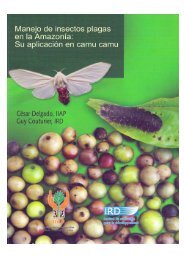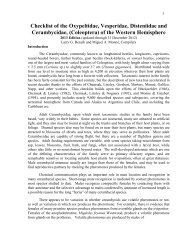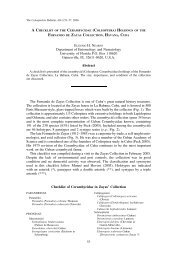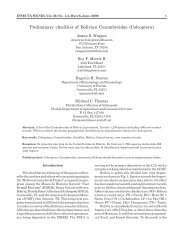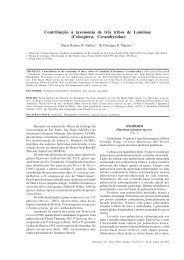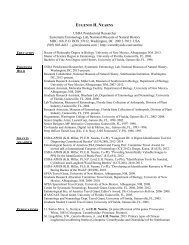Create successful ePaper yourself
Turn your PDF publications into a flip-book with our unique Google optimized e-Paper software.
Introduction Vll<br />
As the shape of the eye is remarkably constant, this structure<br />
is of value only in separating closely related genera and then<br />
principally on differences of size. In Taricanus and Lachaerus,<br />
the eye is nearly divided, so that the two lobes are connected only<br />
by a fine line of ocelli.<br />
On the under surface very few specializations occur. The pros<br />
ternum is usually simple; in some species of Lochtnaeocles, of<br />
Charoides, and in Sternycha, 'there is a more or less distinct trans<br />
verse process medially. Only in this last genus is the metasternum<br />
tuberculated or in any way modified. The fifth sternite is of value<br />
only in distinguishing the sexes, being longer and medially im<br />
pressed in the female.<br />
The legs decrease slightly in length from the more primitive<br />
genera to those more specialized but this is of little value as a dis<br />
tinguishing character. Howeyer, many male secondary sexual spe<br />
cializations on the various segments occur. The procoxae often<br />
are uncate or tuberculate anteriorly; the profemora are frequently<br />
strongly robust, more or less parallel-sided and may be rugose<br />
basally; the metatibiae (rarely also the mesotibiae) are dilated<br />
apically. Sometimes some of these specializations occur also in<br />
the female to a lesser degree.<br />
Size and coloration are remarkably uniform for Cerambycidae.<br />
This constancy of length is true of most species and within genera<br />
differences in length are even less marked-as for the uniformity<br />
of coloration, it is frequently possible to place species to genera<br />
by this feature alone but it is this same characteristic that makes<br />
distinction of the several species of the same genus so difficult.<br />
AFFINITIES<br />
Due to the present unsatisfactory sequence and definitions of<br />
the tribes of the Lamiinae, the relationships of the Onciderini are<br />
not very clearly establishable. However, the following statements<br />
appear evident to the authors: The present tribe displays affinities<br />
to the Saperdini (males) on one hand and the Hipposini on the<br />
other in the form of the front and in other characters, but should<br />
follow, not precede, these two cosmopolitan groups. Its more<br />
highly evolved character is displayed in the compact form of the<br />
body, the specializations of the antennae, highly developed second<br />
ary sexual structures, the clavate femora, and in the unique feed<br />
ing habits. The OnocephaZini and Ischiolonchini are very closely<br />
related tribes of minor importance and should be placed close to



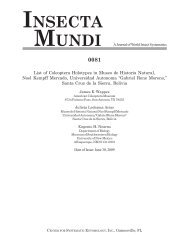
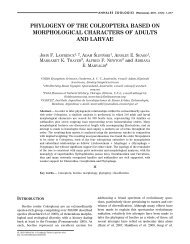


![Coleoptera. Vol. I. [Longicornia. Part I.]](https://img.yumpu.com/41202793/1/180x260/coleoptera-vol-i-longicornia-part-i.jpg?quality=85)
